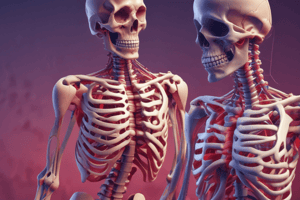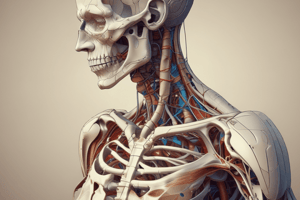Podcast
Questions and Answers
What distinguishes the axial skeleton from the appendicular skeleton?
What distinguishes the axial skeleton from the appendicular skeleton?
- The appendicular skeleton includes limbs and the girdles that attach them. (correct)
- The appendicular skeleton protects vital organs like the heart and lungs.
- The axial skeleton's primary function is to support the body's weight.
- The axial skeleton includes bones of the hands and feet.
Which structure of a long bone stores yellow marrow in adults?
Which structure of a long bone stores yellow marrow in adults?
- Epiphysis
- Medullary Cavity (correct)
- Articular Cartilage
- Diaphysis
Which part of the spine allows for head movement such as nodding and tilting?
Which part of the spine allows for head movement such as nodding and tilting?
- Lumbar Spine
- Sacrum
- Thoracic Spine
- Cervical Spine (correct)
What type of bone is primarily involved in protecting internal organs?
What type of bone is primarily involved in protecting internal organs?
Which statement accurately describes the structure of the diaphysis in a long bone?
Which statement accurately describes the structure of the diaphysis in a long bone?
Which vertebrae are fused together to form the sacrum?
Which vertebrae are fused together to form the sacrum?
What is the main functional purpose of cartilage in the musculoskeletal system?
What is the main functional purpose of cartilage in the musculoskeletal system?
Which muscle group is primarily responsible for moving the limbs?
Which muscle group is primarily responsible for moving the limbs?
What is the primary function of the periosteum in bone structure?
What is the primary function of the periosteum in bone structure?
Which type of muscle is characterized by involuntary control and non-striated fibers?
Which type of muscle is characterized by involuntary control and non-striated fibers?
Which pathology is primarily characterized by progressive muscle weakening, particularly affecting males?
Which pathology is primarily characterized by progressive muscle weakening, particularly affecting males?
What is a significant characteristic of osteomyelitis?
What is a significant characteristic of osteomyelitis?
How does osteoarthritis typically affect the body?
How does osteoarthritis typically affect the body?
Which of the following is NOT a characteristic of skeletal muscle?
Which of the following is NOT a characteristic of skeletal muscle?
What is the condition called that involves an excessive inward curvature of the lumbar spine?
What is the condition called that involves an excessive inward curvature of the lumbar spine?
Which type of muscle is found only in the heart and characterized by rhythmic involuntary contractions?
Which type of muscle is found only in the heart and characterized by rhythmic involuntary contractions?
Flashcards
Axial Skeleton
Axial Skeleton
Part of the skeleton including bones of the head, neck, chest, and back; protects the brain, spinal cord, heart, and lungs, and serves as a base for muscles.
Appendicular Skeleton
Appendicular Skeleton
Part of the skeleton comprising the bones of the upper and lower limbs and their attachments to the axial skeleton
Vertebrae
Vertebrae
33 stacked bones forming the spinal canal protecting the spinal cord and nerves.
Long Bone Structure
Long Bone Structure
Signup and view all the flashcards
Diaphysis
Diaphysis
Signup and view all the flashcards
Epiphysis
Epiphysis
Signup and view all the flashcards
Medullary Cavity
Medullary Cavity
Signup and view all the flashcards
Bone Types
Bone Types
Signup and view all the flashcards
Skeletal Muscle
Skeletal Muscle
Signup and view all the flashcards
Cardiac Muscle
Cardiac Muscle
Signup and view all the flashcards
Smooth Muscle
Smooth Muscle
Signup and view all the flashcards
Osteoarthritis
Osteoarthritis
Signup and view all the flashcards
Muscular Dystrophy
Muscular Dystrophy
Signup and view all the flashcards
Paralysis
Paralysis
Signup and view all the flashcards
Osteoporosis
Osteoporosis
Signup and view all the flashcards
Study Notes
Musculoskeletal System Overview
- The musculoskeletal system comprises bones, muscles, joints, tendons, and cartilage.
- Its purpose includes supporting the body, facilitating movement, protecting organs, and producing red blood cells.
- The system is often studied together despite its individual components.
Learning Objectives
- Students will examine the anatomy of the skeletal and muscular systems.
- They will identify the functions of each system.
- Students will be able to recognize common diseases, disorders, and procedures related to these systems.
Skeletal System Components
- Axial Skeleton: Comprises bones of the head, neck, chest, and back. It protects the brain, spinal cord, heart, and lungs. It also serves as a point of attachment for muscles controlling these areas. (80 bones)
- Appendicular Skeleton: Includes bones of the upper and lower limbs and the bones connecting these limbs to the axial skeleton. (126 bones)
- Bones types: include flat bones (e.g., cranium, ribs), short bones (e.g., wrists, ankles) and long bones (e.g., arms, legs, hands).
Skeletal System Structure (Examples)
- Skull: Contains the skull bones and auditory bones
- Vertebral Column: Composed of vertebrae, sacrum, and coccyx (providing support and protection of spinal cord)
- Rib Cage: Consists of ribs and sternum
- Appendicular Skeleton components: Shoulder girdle (clavicle , scapula), arm bones (humerus , ulna, radius, carpals, metacarpals, phalanges), hip bone (pelvic girdle) , leg bones (femur, tibia, fibula, tarsals, metatarsals, phalanges)
Vertebrae Segments
- Cervical Spine (Neck): Seven vertebrae (C1-C7) allowing head movement
- Thoracic Spine (Middle Back): Twelve vertebrae (T1-T12) where ribs attach
- Lumbar Spine (Lower Back): Five vertebrae (L1-L5) supporting weight and stress
- Sacrum: Five fused vertebrae (S1-S5) connecting to the hips
- Coccyx (Tailbone): Four fused vertebrae, attaching to the pelvic floor
Long Bone Structure
- Diaphysis: The shaft of a long bone, made of compact bone, surrounding the medullary cavity(containing yellow marrow in adults).
- Epiphysis: The ends of the long bone made of spongy bone, covered with articular cartilage. ( contains red bone marrow)
Other Components/ Tissues
- Muscles: Skeletal, cardiac, smooth
- Tendons: Connect muscle to bone
- Cartilage: Found at bone ends (e.g., nose)
- Ligaments: Connect bone to bone
Types of Muscles
- Skeletal Muscle: Voluntary control, striated fibers, moves bones.
- Cardiac Muscle: Found only in the heart, rhythmically involuntary contractions, striated.
- Smooth Muscle: Involuntary control, non-striated, found in organs.
Body Movements
- Adduction: Movement toward the midline
- Abduction: Movement away from the midline
- Flexion: Decreasing the angle of a joint
- Extension: Increasing the angle of a joint
- Rotation: Movement around an axis
- Pronation: Turning the palm down
- Supination: Turning the palm up
- Inversion: Turning the sole inward
- Eversion: Turning the sole outward
- Dorsiflexion: Elevating the foot
- Plantar Flexion: Lowering the foot
Common Pathologies
- Muscular Dystrophy: Progressive muscle weakening
- Osteoarthritis: Cartilage/bone breakdown
- Osteomyelitis: Bone infection
- Osteoporosis: Progressive bone loss
- Rheumatoid Arthritis (RA): Autoimmune joint inflammation
- Ankylosing Scoliosis: Abnormal lateral curvature of the spine
- Carpal Tunnel Syndrome: Numbness/pain in wrist/hand
- Gout: Uric acid buildup
- Kyphosis: Abnormal forward curvature of thoracic spine
- Lordosis: Excessive inward curvature of lumbar spine
Types of Paralysis
- Paraplegia: Paralysis of the lower body
- Quadriplegia: Paralysis of all four limbs
- Hemiplegia: Paralysis of one side of the body
- Hemiparesis: Partial paralysis of one side of the body
- Myoparesis: Partial paralysis or muscle weakness
Combining Forms (Medical Terminology)
- A table providing combining forms and corresponding terms, relevant medical contexts.
Studying That Suits You
Use AI to generate personalized quizzes and flashcards to suit your learning preferences.




